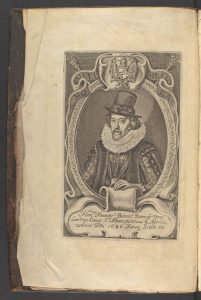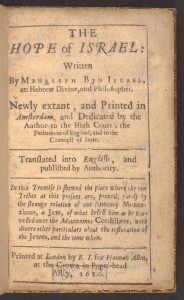Early Modern Women and Printing
By Sarah S Pipkin, on 8 March 2023
The following was adapted from text written by Erika Delbecque and Tabitha Tuckett for the 2023 exhibition catalogue Hidden in Plain Sight: Liberating our Library Collections, which will be available online at the end of March. The Main Library exhibition Hidden in Plain Sight will also be opening at the end of March. Keep an eye out for an opening date announcement coming soon!
Often when we look at books in our collection, our preconceived notions about the historical roles of women in society can cause us to make assumptions about the history of an item. After all, what could the collected works of Francis Bacon, a former Lord High Chancellor of England, tell us about the working lives of women in 17th century England?
When you first open the 1657 edition of Resuscitatio your eye is almost immediately drawn to the full-page engraved portrait of Francis Bacon. However, this book is part of the long history of women’s involvement in book production.

Portrait of Bacon from Resuscitatio
In early modern England, printing was mostly the preserve of men. However, widows were permitted to take over their late husbands’ printing businesses, which allowed many women a way into this profession. One of these women was Sarah Griffin, who was active as a printer from 1653 to 1673. We can see her involvement in the production of the 1657 edition of Resusciatio by taking a closer look at the title page.

Title page of Resuscitatio (STRONG ROOM OGDEN A QUARTO 329)
The bottom of the title page for Resuscitatio reads: “LONDON, Printed by Sarah Griffin, for William Lee, and are to be sold at his Shop in Fleetsstreet, at the sign of the Turks-head, near the Mitre Tavern, 1657.”

Publishing information for Resuscitatio
Sarah Griffin inherited the printing business from her husband Edward in 1652 and ran it successfully for the next 20 years. We have several books printed by Sarah Griffin in our collection, including her edition of Resuscitatio.
Hannah Allen was another example of a woman who acquired a business on her husband Benjamin’s death in 1632. While it is unclear how long she was involved in publishing, from 1646-1651 Allen published at least 54 books and pamphlets. Her business specialised in religious treatises, such as The hope of Israel. It is an English translation of a work by Menasseh ben Israel, who set up the first Hebrew printing press in Amsterdam.

Title page for The hope of Israel (STRONG ROOM MOCATTA 1650 M1 (5))
Like the 1657 edition of Resuscitatio, a quick glance at The hope of Israel does not reveal an obvious connection to women-owned businesses. However, the bottom of the title page reads: “Printed at London by R.I. for Hannah Allen, at the Crown in Popes-head Alley, 1650.”

Publisher information for The hope of Israel
Our collection includes The hope of Israel and the 1648 pamphlet The humble ansvver of the General Councel of the Officers of the Arm.
Both of these items were identified as part of the Rare Books Liberating the Collections volunteer project, which equipped participants with the knowledge and tools to search our catalogue for items in our rare book collections relating to under-represented groups. Twenty-seven volunteers have worked with us, each focusing on a particular topic, such as books owned by women, authors of colour and representations of disability. Without the work of these volunteers, we may have never realised that Resuscitatio and The hope of Israel were part of the history of women in publishing and printing.
Both of these items were identified by Emilia Reid, a 2021 and 2022 Rare Books Liberating the Collections volunteer.
 Close
Close


